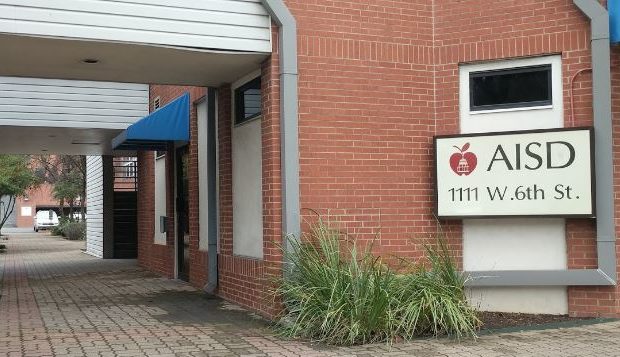AISD board debates how to prevent a financially insolvent school district
Wednesday, April 11, 2018 by
Jessi Devenyns When Austinites passed the $1 billion Austin Independent School District bond that was intended for major improvements in school facilities as well as transportation and district-wide improvements to technology for teachers and students, they knew they were voting to provide the school district with a much-needed financial boost. However, even with a significant amount of aid from the public, annual taxes are still required to fund teachers’ salaries and educational programming, and the city’s school district is still finding themselves pinched for cash.
At the April 9 meeting of AISD’s board of trustees, Chief Financial Officer Nicole Conley Johnson announced that for the upcoming 2019 school year, the administration has an estimated budget deficit of $30 million.
“(We need to) address our budget challenges before our deficit overtakes us,” she informed the board.
Naturally, anyone who pays property taxes in the city of Austin just flinched at the idea of AISD trying to generate more funding to cover its $1.4 billion budget. However, so did the trustees, and a great portion of the discussion revolved around Austin’s inability to utilize all of the city’s property tax dollars.
Although 54 percent of property tax bills are funding AISD, only a percentage of that goes to the local district. The rest is recaptured by the state of Texas and redistributed. Even with the chief appraiser estimating that local property values will increase by 10.07 percent, which will net $114 million more in local property tax, Conley Johnson estimates that AISD will need to provide the state with a $123 million increase in recapture dollars. That means the district will owe $9 million more than it collects.
“The amount of money we are sending away is sickening,” lamented Trustee Julie Cowan.
This complaint, however, is not unique to Austin. In fact, the state of Texas as a whole is ranked 36 out of all 50 states in terms of funding.
“If things continue on the same, despite how wealthy our community is … we’re going to be insolvent basically and unable to pay our workers a living wage,” said Trustee Edmund Gordon.
Already, Conley Johnson expressed her concerns about being able to pay AISD staff. She explained that the budget currently assumes no increases for employee compensation or employer contributions to the employee health plan. The only exception to this is for bilingual teachers serving in a bilingual-identified campus. These educators currently receive a $2,500 stipend, which is in the budget to be raised to $4,000 for the 2019 school year.
She also indicated that the district will be asking for some modest increases in programs including advanced early literacy and enrollment, which are planned to increase the budget by an additional $3.4 million, because even with the budgetary constraints, AISD will continue to try and minimize any adverse impacts to the classroom. Superintendent Paul Cruz noted that before finance cuts a line item, they should be asking the same question, “How do we keep everything in the classroom intact?”
The unwavering focus on not affecting education does, however, require sacrifice to meet the shortfall in funding. “We realize it’s going to necessitate some of the more controversial reductions,” explained Conley Johnson.
Cowan acknowledged that hard cuts were the only path forward, but she asked rhetorically, “Do we have the wherewithal to make really hard decisions when they’re presented to us?”
Some of the proposed options to reduce expenditures include eliminating partial pay during workers’ compensation and extended leave, eliminating district-wide marketing contracts, reducing grass-cutting contracts, and canceling portable leases and moves. Conley Johnson also suggested potentially reducing extra programs like early college preparation and Covington Middle School’s dyslexia program.
But even so, the total wouldn’t come close to closing a $30 million gap. “I don’t see there’s any way to (achieve) $30 million in reductions without touching classrooms,” said Conley Johnson. “There’s this sort of simplicity around thinking we can do more with less. And we can’t.”
Trustee Amber Elenz reminded the board that the untenable situation that AISD finds itself in is no doomsday preparation scenario. It’s real.
She said, “When I came on in 2012, we had a $30 million deficit. In 2013, we had a $30 million deficit.” But, she said, that was just finance being conservative and planning for the worst. “Now, it is truly $30 million. This is much more real.”
President Kendall Pace concluded, “I hate to repeat what everyone already knows, (but) what do we do?”
The Fiscal Year 2018-19 preliminary budget is scheduled to be released on April 23. Following its release, there will be a community engagement process before the recommended budget is presented in May. The final adoption of the budget is scheduled for June 25.
This story has been updated to correct a name misspelling.
The Austin Monitor’s work is made possible by donations from the community. Though our reporting covers donors from time to time, we are careful to keep business and editorial efforts separate while maintaining transparency. A complete list of donors is available here, and our code of ethics is explained here.
You're a community leader
And we’re honored you look to us for serious, in-depth news. You know a strong community needs local and dedicated watchdog reporting. We’re here for you and that won’t change. Now will you take the powerful next step and support our nonprofit news organization?


